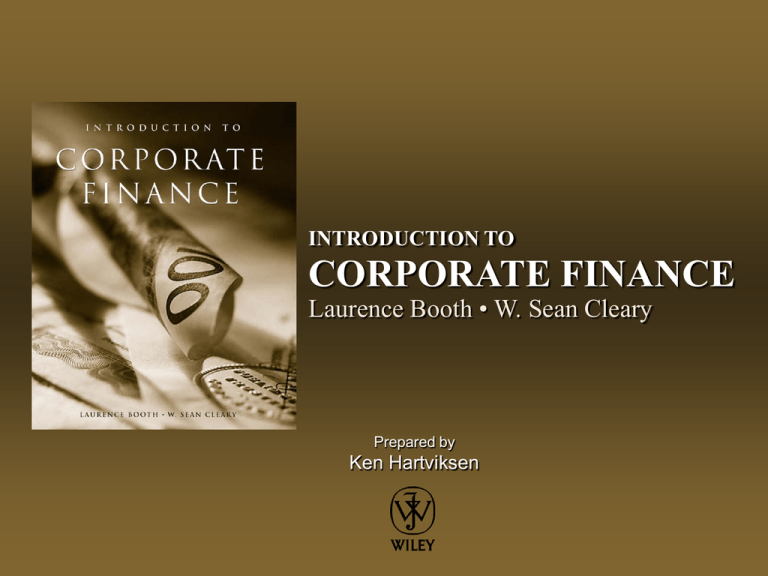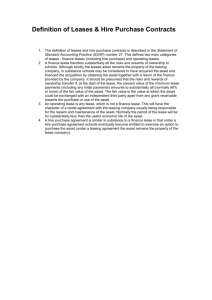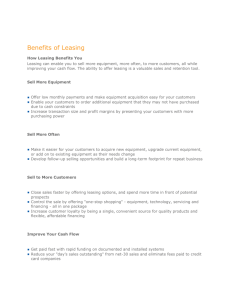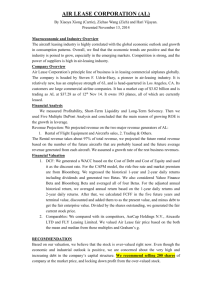
INTRODUCTION TO
CORPORATE FINANCE
Laurence Booth • W. Sean Cleary
Prepared by
Ken Hartviksen
CHAPTER 16
Leasing
Lecture Agenda
•
•
•
•
•
Learning Objectives
Important Terms
Leasing Arrangements
Accounting for Leases
Evaluating the Lease
Decision
• Motivation for Leasing
• Summary and
Conclusions
– Concept Review Questions
CHAPTER 16 – Leasing
16 - 3
Learning Objectives
•
•
•
•
The basic characteristics of leases and
how to differentiate between operating
and financial (or capital) leases
The accounting treatment of both
operating and financial leases
The benefits and disadvantages of
leases
How the lease decision can be
evaluated using the discounted cash
flow valuation methods
CHAPTER 16 – Leasing
16 - 4
Important Chapter Terms
• Asset-based lending
• Captive finance
companies
• Financial lease
• Lessee
• Lessor
• Leveraged lease
• Off-balance-sheet
financing
• Operating lease
• Sale and leaseback (SLB)
agreement
• Secured financing
• Small and medium-sized
enterprises (SMEs)
CHAPTER 16 – Leasing
16 - 5
Leasing Arrangements
Introduction
• The decision to invest in an asset that has a long life is a
capital budgeting decision.
• The decision to acquire is a separate decision from the
decision on the method of financing the acquisition
• When these two decisions are combined, this is called
asset-based lending because the financing is tied
directly to a particular asset.
• Examples of asset-based lending include:
– Secured loans
– Conditional sales contracts
– Leases
CHAPTER 16 – Leasing
16 - 6
Leasing Arrangements
The Institutional Framework
•
Canadian Finance and Leasing Association (CFLA) acts
as the trade association for asset-based lenders
–
–
160 members
Represents three group of financial companies:
1. Independent asset-based finance companies
–
–
Involved in machinery and equipment financing with 60% of
customers begin SMEs.
40% of the assets financed are transportation equipment (buses,
trucks, trailers or office equipment)
2. Captive finance companies of major manufacturers (eg. GMC
Finance and Ford Credit Canada) where 1/3 of all new vehicles
are leased.
3. Chartered banks
–
Chartered banks are not allowed to lease consumer household
property and are therefore focussed on leasing commercial
transportation equipment and real property such as land and buildings
CHAPTER 16 – Leasing
16 - 7
Lease
What is it?
A lease contract is an agreement where the owner
conveys to the user the right to use an asset in return
for a number of specified payments over an agreed
period of time
Lessor is the owner of the asset
Lessee is the user of the asset
CHAPTER 16 – Leasing
16 - 8
Leasing
Types of Leases
Operating Lease
• A lease where some of the benefits of ownership do not
transfer to the lessee and remain with the lessor.
Financial (Capital) Lease
• A lease where essentially all the benefits of ownership
transfer to the lessee; also known as a capital or full payout
lease.
(See Table 16-1 on the following slide for the distinguishing features between
the two types of leases)
CHAPTER 16 – Leasing
16 - 9
Types of Leases
Operating versus Financial Leases
Table 16-1 Operating versus Financial Leases
OPERATING
Lessee
FINANCIAL
Lessor
Lessee
Lessor
Asset
Not on balance
sheet (B/S);
disclose in
footnotes
Report on B/S
Report on B/S
Not on B/S
Lease payments
Expense the
full amount as
rental expense
Claim as rental
income
Claim the
interest portion
of payments
received as
interest income
Depreciation
expense
(associated with
leased asset)
Cannot claim
Claim
Decompose
into interest
and principal
repayment, and
expense the
interest portion
Claim
CHAPTER 16 – Leasing
Cannot claim
16 - 10
Conditional Sales Agreement
What is it? CRA Perspective
According to Canada Revenue Agency (CRA) a conditional sales
agreement exists if one of the following occurs:
• The lessee automatically acquires ownership at some point
• The lessee is required to buy the asset at some point or guarantee
that the lessor gets a certain value for it
• The lessee has the right to buy the asset at some point for
substantially less than the likely fair market value
• The lessee has the right to buy the asset at a price that would cause
a reasonable person to conclude that they will buy it.
CRA’s interest in this issue is that it must determine which party
to the contract has the legal right to claim CCA for tax purposes.
If any of the other above conditions are satisfied, CRA regards
the user (lessee) as having the right to claim CCA.
CHAPTER 16 – Leasing
16 - 11
Financial/Capital/Full Payout Lease
What is it? Accounting Perspective
According to the Canadian Institute of Chartered Accountants
(CICA), all of the benefits of ownership transfer to the lessee with
these lease agreements.
The lessee is deemed to own the asset and will claim
depreciation on the firm’s income statement and record the value
as an asset and liability on the balance sheet.
Such leases usually:
•
•
•
•
Require the lessee to carry out maintenance and insure the asset
Provides the lessee with a fixed purchase option
The lease agreement covers 75% of the economic life of the asset
Is structured so that the present value of lease payments exceeds
90 % of the cost
• Involves fixed rental payments.
CHAPTER 16 – Leasing
16 - 12
Operating Lease
What is it? Accounting Perspective
• If a lease is NOT a capital lease, then it is an
operating lease
• Operating leases do not transfer to the lessee the
benefits of ownership (ability to deduct CCA)
CHAPTER 16 – Leasing
16 - 13
Sale and Leaseback Agreement
What is it?
• An agreement in which the owner of an asset sells it
to another party and then leases the asset back
• Popular type of lease for organizations in low tax
brackets because they are unable to use the tax
shield offered by CCA
• SLBs can mean that part of the tax savings can be
transferred back to the seller in the form of lower
lease payments, reducing the cost of the asset
• 1989 federal budget significantly reduced the benefits
from such agreements by forcing the lessor to deduct
depreciation on leased assets only from income
derived from leasing.
CHAPTER 16 – Leasing
16 - 14
Leveraged Lease
What is it?
• A three-way agreement among the lessee, the lessor,
and a third party lender in which the lessor buys the
asset with only a small down payment and the lender
supplies the financing
• Popular in U.S. because lessor puts up only a portion
of the asset purchase price, but receives all of the tax
benefits of ownership
• Not popular in Canada because CRA restricts use of
CCA to the party at risk, and CCA deductions cannot
be carried over to offset taxes on other income
CHAPTER 16 – Leasing
16 - 15
Accounting for Leases
Accounting for Leases
•
Financial leases are included on the balance
sheet of the lessee
– Present value of all lease payments is recorded on
the right-hand side of the balance sheet
– The same amount is recorded as an asset on the
left-hand side of the balance
•
Operating leases are off-balance-sheet
financing for the lessee (included only in the
notes to the financial statements)
CHAPTER 16 – Leasing
16 - 16
Accounting for Leases
Financial Statement Effects of Lease Classification
Capital/Financial/Full Payout Leases:
Income Effects
1. Net income will generally be lower for capital leases in the early
years and higher in the later years.
2. CFO will be higher with capital leases. CCA may be deducted
in measuring Net Income after tax, however, CCA is added
back when determining CFO. Capital/ financial leases expense
only the interest portion of the payments in determining EBT.
Balance Sheet Effects
1. Lower current ratios, higher debt and leverage ratios, lower
asset turnover and lower profitability ratios (especially in the
early years of asset life)
CHAPTER 16 – Leasing
16 - 17
Accounting for Leases
Financial Statement Effects of Lease Classification
Operating Leases:
Income Effects
1. Net income will generally be higher for operating leases in the
early years and lower in the later years because interest
expense charged for the financial lease declines as the liability
is amortized by the lease payments.
2. CFO will be lower with operating leases since the full lease
payment is subtracted from CFO, unlike financial leases where
only the interest portion of the payments is subtracted.
Balance Sheet Effects
1. Higher current ratios, lower debt and leverage ratios, higher
asset turnover and higher profitability ratios (especially in the
early years of asset life)
CHAPTER 16 – Leasing
16 - 18
Evaluating the Lease Decision
Lease Versus Buy
•
•
Leasing is an alternative means of obtaining the use of
an asset
There are four main differences in the cash flows for a
company that leases an asset instead of buying it:
1. It does not have to pay for the asset up front
2. It does not get to sell the asset when it is finished with it, if it is
an operating lease, or if title is not transferred through a
financial lease
3. It makes regular lease payments. If the lease is an operating
lease, then the full amount of the lease payments is tax
deductible; only the interest portion is deductible for capital
leases
4. Operating leases are not depreciated.
CHAPTER 16 – Leasing
16 - 19
Evaluating the Lease Decision
Lease Versus Buy Evaluative Frameworks
IRR of Leasing Analysis
– Estimate incremental cash flows that result from
leasing
– Solve for the discount rate (IRR) that equates the
incremental cash flows with the initial value of the
asset. (This is the after-tax IRR or cost of leasing)
• If IRR of leasing > after-tax cost of borrowing (borrow and
buy the asset)
• If IRR of leasing < after-tax cost of borrowing (lease the
asset)
CHAPTER 16 – Leasing
16 - 20
Evaluating the Lease Decision
Lease Versus Buy Evaluative Frameworks
NPV of Leasing Analysis
– Estimate incremental cash flows that result from
leasing
– Calculate NPV using after-tax cost of borrowing as
the discount rate.
• If NPV of leasing is – (borrow and buy the asset)
• If NPV of leasing + after-tax cost of borrowing (lease the
asset)
CHAPTER 16 – Leasing
16 - 21
Motivation for Leasing
1. Cheaper financing (which party can make
better use of the CCA tax shield/)
2. Reduce the risks of asset ownership
3. Implicit interest rates
4. Maintenance
5. Convenience
6. Flexibility
7. Capital budgeting restrictions
8. Financial statement effects
CHAPTER 16 – Leasing
16 - 22
Summary and Conclusions
In this chapter you have learned:
– That firms can gain the use of assets through
leasing rather than outright ownership
– The general differences between operating and
financial leases
– How to evaluate a potential lease decision using
discounted cash flow analysis
– The various reasons firms might have for
entering into lease arrangements
CHAPTER 16 – Leasing
16 - 23
Copyright
Copyright © 2007 John Wiley & Sons Canada, Ltd. All rights
reserved. Reproduction or translation of this work beyond that
permitted by Access Copyright (the Canadian copyright licensing
agency) is unlawful. Requests for further information should be
addressed to the Permissions Department, John Wiley & Sons
Canada, Ltd. The purchaser may make back-up copies for his or her
own use only and not for distribution or resale. The author and the
publisher assume no responsibility for errors, omissions, or
damages caused by the use of these files or programs or from the
use of the information contained herein.
CHAPTER 16 – Leasing
16 - 24




